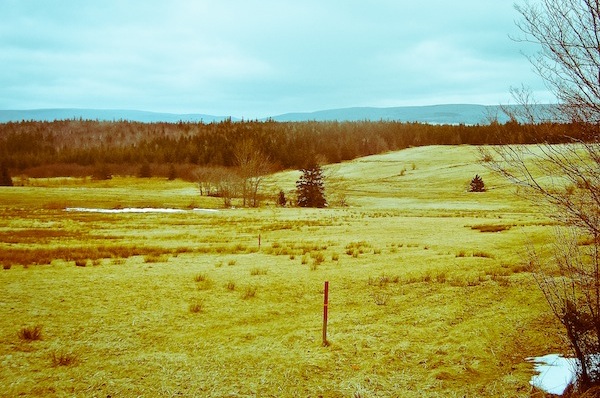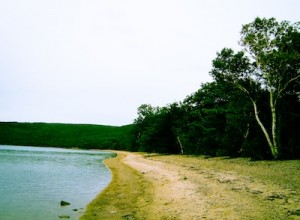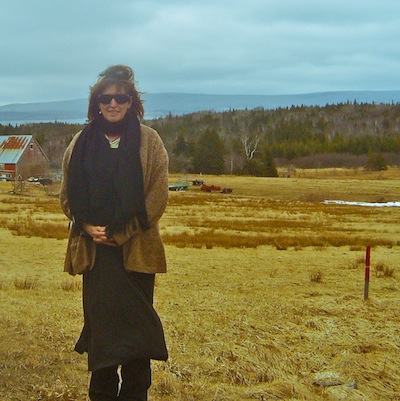
It’s easy to understand why Robert and Rebecca Parkins purchased a home here four years ago. With 40 acres of land along the lake’s shore, they had hopes of fulfilling some of their lifelong dreams to live a more sustaining, healthy and natural lifestyle. To them, Lake Ainslie was heaven on earth, and the ideal place to spend the rest of their lives in pursuit of their dreams. The couple sold their successful business and home in Ontario and came to Cape Breton to start over, knowing full well that it would take guts, ingenuity and hard work to make a go of it on an island with a reputation for having limited economic opportunities and plenty of hardship. But the Parkins’ had fallen in love.
“I think Cape Breton attracts a certain kind of person,” Rebecca Parkins noted. “If you come here with the wrong intentions, you’re cooked! You’re not going to survive. But I think we came here with the right intention.”
Rebecca Parkins also came with a five year business plan, and set to work establishing a new wellness clinic called Healing Time in Whycogomagh, where she practices message therapy and sells natural healthcare products. It seemed like the Parkins’ were well on the way to realizing their goals and beginning to live their dream on Cape Breton Island. But two years into their new adventure, an unexpected event occurred.
Rebecca recalls when she started to hear rumours in her clinic after a seismic crew from the oil and gas industry had done testing around Lake Ainslie. “We got told that there were huge deposits of oil at Lake Ainslie, and that it was bigger than Fort Mac,” Parkins recalls, nodding at my look of disbelief.
Were the dreams of many a Cape Breton mother going to be answered? Would this development allow their sons and daughters to come home from out west, and earn a substantial living right here in their rural community? Or was the community being prepped to accept the industrial development by leaking information that promised an economic boom that would put an end to the hardships that families in Cape Breton have been coping with?

Rebecca Parkins admits, “I knew absolutely nothing about oil wells or the oil industry at that time, but my husband, being a millwright knew a little bit more, and thought that we should get some more information, to find out exactly what is going on here, what they plan on doing, and how it’s going to affect us”. The Parkins’ began writing letters to government officials, and the well-site developer, PetroWorth. Their letters to PetroWorth went unanswered and government replies, if any, were general and lacked any real answers to their questions.
A news release on the PetroWorth website from July 2009 announces that “PetroWorth has 100% exploration and development rights to 383,000 acres on the Lake Ainslie Block. Over the years, numerous oil seeps to surface have been observed on this property. Moreover, in the late 1800s and early 1900s, a number of shallow wells were drilled on the Lake Ainslie Block, most of which encountered oil and/or natural gas.” In the same release the company states that the “strategy of the company is to conduct aggressive exploration programs on these permits”.
In a similar news release from October 2010, the company reports that it “has submitted an application to the Nova Scotia Department of Energy for ‘Authority to Drill’ an oil exploration well on the Company’s Lake Ainslie Block property in Cape Breton” and that the “proposed well will be drilled at least 800 metres deeper than any previous well in the area. In addition to the oil-bearing shallow zones, the Company is targeting a deeper structure in the Strathlorne formation”. PetroWorth declined requests for an interview for this article.
When PetroWorth announced that they had successfully secured a surface lease from a local resident, the Parkins’ were shocked to learn it was from their neighbour. Their concerns were obviously heightened and they started to write more letters demanding information about the development, again without success. Rebecca Parkins noted, “it was about the same time when the Council of Canadians approached us and asked us to watch [the film] Gasland, which very much opened our eyes.” The Parkins’ tried to reach out to their neighbour, whose home is 75 meters from the drill site. “We’ve been told by geologists who have come out here, that his home will be shaken off the ground. But the company’s geologists won’t tell him that. They spin information to the people they want to lease land from, tell them that people are going to love them for bringing this development here.”
The Parkins’ then started to really investigate what this development was going to mean for their community. They got in touch with residents from other areas where similar developments have taken place. Rebecca Parkins says they were told, “that the company will come in and drill three or four wells. They won’t say anything about what they are finding. Then all of a sudden, they’re coming in, drilling more wells, and they are fracking.” Hydraulic fracturing, or “fracking” is a controversial process where large amounts of water mixed with chemicals are injected under high pressure into a well to create fissures in the bedrock, so fossil fuels can be extracted. Although the process has been used by the industry for the past 40-50 years, Parkins has learned that only in the last four years have four different techniques been used in combination, those being the use of slick water (chemicals), horizontal fracking, high pressure extraction, and the use of multiple wells, which has increased contamination and caused unexpected events. Wikipedia’s list of potential environmental impacts associated with fracking includes: air emissions and pollution, groundwater contamination, radioactive contamination, earthquakes, and greenhouse gas emissions.
As the Parkins’ learned more about fracking, their worry increased, especially after learning that much of the chemicals and contaminated water is left underground where no one can tell if it will seep into aquifers or the lake, not to mention the air and noise pollution that will be created in the process. Rebecca Parkins worries about the bald eagles who nest near the drill site, about the children who play across the road, and the other 7 homes that are within a kilometer of the site.
However, it is not just the controversial use of fracking that this community opposes. The more research they do on the oil and gas industry, the more they are opposed to any oil or gas drilling in their watershed, or any community for that matter, where it is not wanted by the people who live there.
Parkins tells me that her community is waking up to the fact that they need to decide what type of developments they want, what kind of jobs they need to provide. She is adamant, that as a community, they can provide sustainable opportunities that won’t pollute their water, that won’t leave behind a legacy of toxic chemicals and waste for future generations. “We don’t need industry coming here to provide jobs. We can provide for ourselves. We just need to think a little bit differently,” she says.

For now, the site next to Rebecca and Robert Parkins’ home is quiet and peaceful. A few markers staked into the field are all that tell of a complex and important battle that is happening between this rural Cape Breton community, and its concerns and desires for a sustainable and healthy future, versus the agenda of government bureaucrats and oil and gas companies who are pursuing the development of oil and gas extraction on the shores of Lake Ainslie.
“It has to stop,” Rebecca Parkins says quietly. “They will not get the drill in the ground. I’m not going to allow it to happen within 600 meters of our largest freshwater lake, within a kilometer of 7 homes. If this goes ahead it sets a precedent and these companies will have carte blanche for drilling anywhere in this province. Nowhere will be safe.”
Learn more about efforts to protect Lake Ainslie and to save Lake Ainslie.

